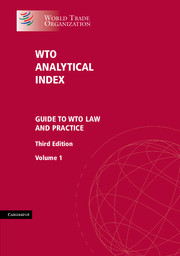Book contents
- Frontmatter
- Contents
- Foreword
- Volume 1
- Introduction
- Marrakesh Agreement Establishing the World Trade Organization (WTO Agreement)
- General Agreement on Tariffs and Trade 1994
- Agreement on Agriculture
- Agreement on Sanitary and Phytosanitary Measures (SPS Agreement)
- Agreement on Textiles and Clothing
- Agreement on Technical Barriers to Trade
- Agreement on Trade-Related Investment Measures
- Agreement on Implementation of Article VI of the General Agreement on Tariffs and Trade 1994 (Anti-Dumping Agreement)
- Agreement on Implementation of Article VII of the General Agreement on Tariffs and Trade (Customs Valuation Agreement)
- Agreement on Preshipment Inspection
- Agreement on Rules of Origin
- Agreement on Import Licensing Procedures
- Volume 2
- Index by Subject
- Index by Case
Agreement on Textiles and Clothing
from Volume 1
Published online by Cambridge University Press: 04 August 2017
- Frontmatter
- Contents
- Foreword
- Volume 1
- Introduction
- Marrakesh Agreement Establishing the World Trade Organization (WTO Agreement)
- General Agreement on Tariffs and Trade 1994
- Agreement on Agriculture
- Agreement on Sanitary and Phytosanitary Measures (SPS Agreement)
- Agreement on Textiles and Clothing
- Agreement on Technical Barriers to Trade
- Agreement on Trade-Related Investment Measures
- Agreement on Implementation of Article VI of the General Agreement on Tariffs and Trade 1994 (Anti-Dumping Agreement)
- Agreement on Implementation of Article VII of the General Agreement on Tariffs and Trade (Customs Valuation Agreement)
- Agreement on Preshipment Inspection
- Agreement on Rules of Origin
- Agreement on Import Licensing Procedures
- Volume 2
- Index by Subject
- Index by Case
Summary
GENERAL
1. The Agreement on Textiles and Clothing (ATC) was negotiated in the Uruguay Round of Trade Negotiations. It replaced the Arrangement Regarding International Trade in Textiles (MFA, or Multi-Fibre Arrangement) of 20 December 1973. The ATC provided for all then-existing textile and clothing trade restrictions to be notified and eliminated over a period of 10 years from the date of entry into force of the WTO Agreement. The ATC also provided that the ATC itself would be terminated at the beginning of the 12th year of the WTO, together with all of the remaining restrictions within its scope. As this termination duly took place on 1 January 2005, the ATC is no longer in effect.
2. For additional information on practice under the ATC during the 1995–2005 period, see earlier editions of the WTO Analytical Index.
PREAMBLE
A. TEXT OF THE PREAMBLE
Members,
Recalling that Ministers agreed at Punta del Este that “negotiations in the area of textiles and clothing shall aim to formulate modalities that would permit the eventual integration of this sector into GATT on the basis of strengthened GATT rules and disciplines, thereby also contributing to the objective of further liberalization of trade”;
Recalling also that in the April 1989 Decision of the Trade Negotiations Committee it was agreed that the process of integration should commence following the conclusion of the Uruguay Round of Multilateral Trade Negotiations and should be progressive in character;
Recalling further that it was agreed that special treatment should be accorded to the least-developed country Members;
- Type
- Chapter
- Information
- WTO Analytical IndexGuide to WTO Law and Practice, pp. 597 - 632Publisher: Cambridge University PressPrint publication year: 2012



